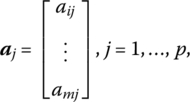7Linear Programming and the Theory of the Firm1
7.1 The Technology of the Firm
To gain some insight into how linear programming may be utilized to solve a variety of resource allocation or general economic decision problems facing the firm, we shall first examine the structure of what may be called the firm’s linear technology. To this end, let us define a production process or activity as a particular method for performing an economic task, e.g. a physical operation that transforms a flow of scarce inputs into a flow of output in a prescribed or technologically determined fashion. Moreover, the factor input proportions are assumed to be fixed and returns to scale (the output response to a proportionate increase of all inputs) are constant as the inputs are varied. Hence, increasing the output of a particular process by a fixed amount can only occur if we increase “each” factor input by the same amount so that factor proportions are invariant.
More specifically, if we have m scarce inputs, each of which is used by p separate activities in fixed amounts, then the jth simple activity may be denoted as the (m × 1) vector

where the (constant) element aij is interpreted as “the minimum amount of factor i, i = 1, …, m, required to operate activity j,j = 1, …, p, at the unit level.” Thus, to produce one unit of output using activity j, we must utilize a1j units of factor 1, a
Get Linear Programming and Resource Allocation Modeling now with the O’Reilly learning platform.
O’Reilly members experience books, live events, courses curated by job role, and more from O’Reilly and nearly 200 top publishers.

